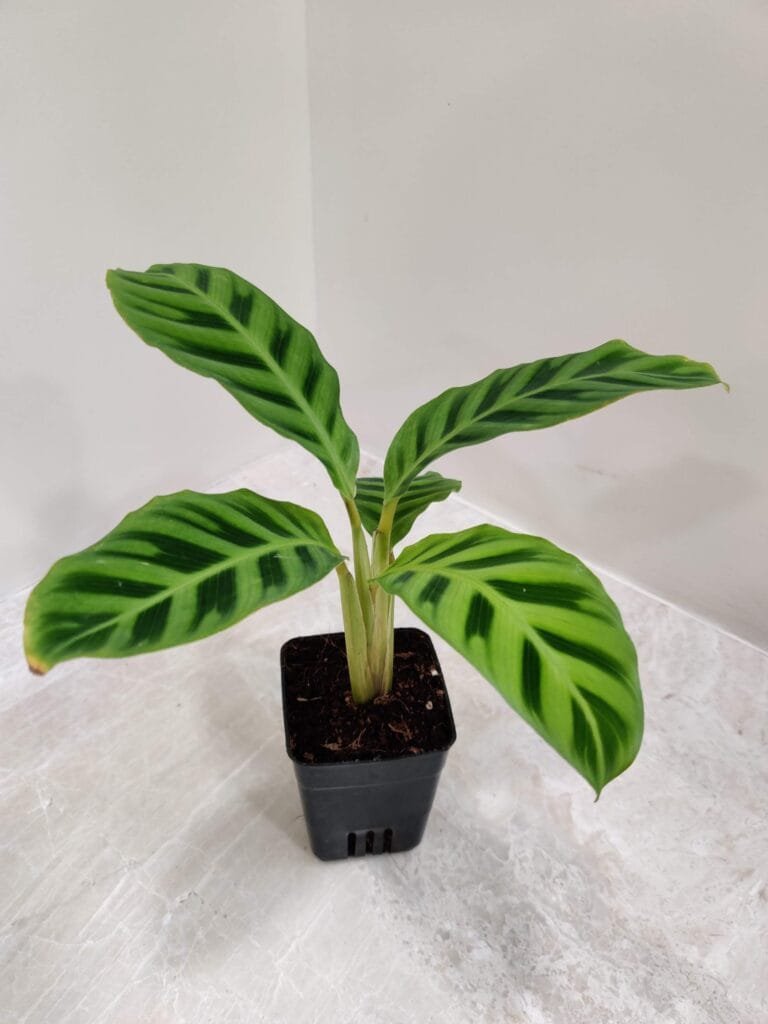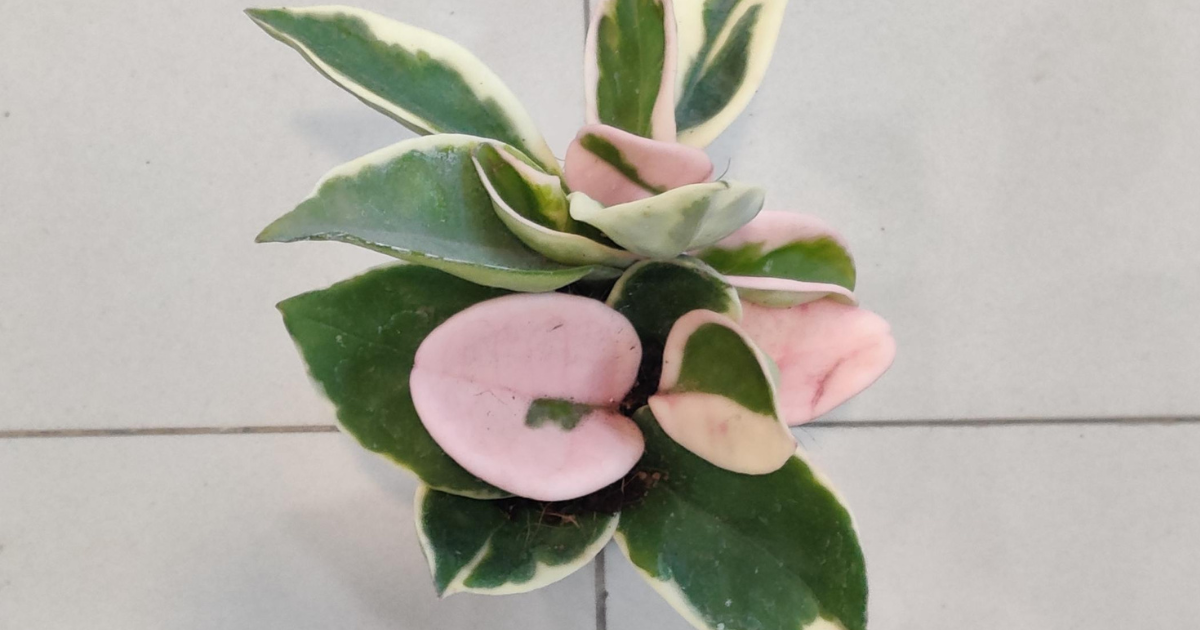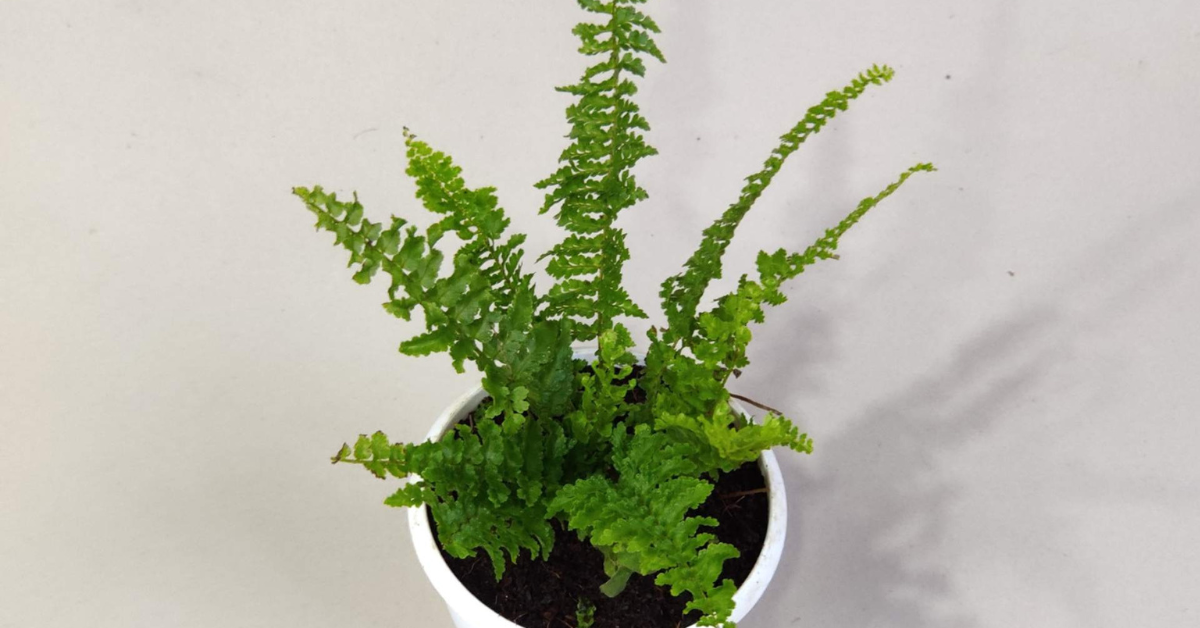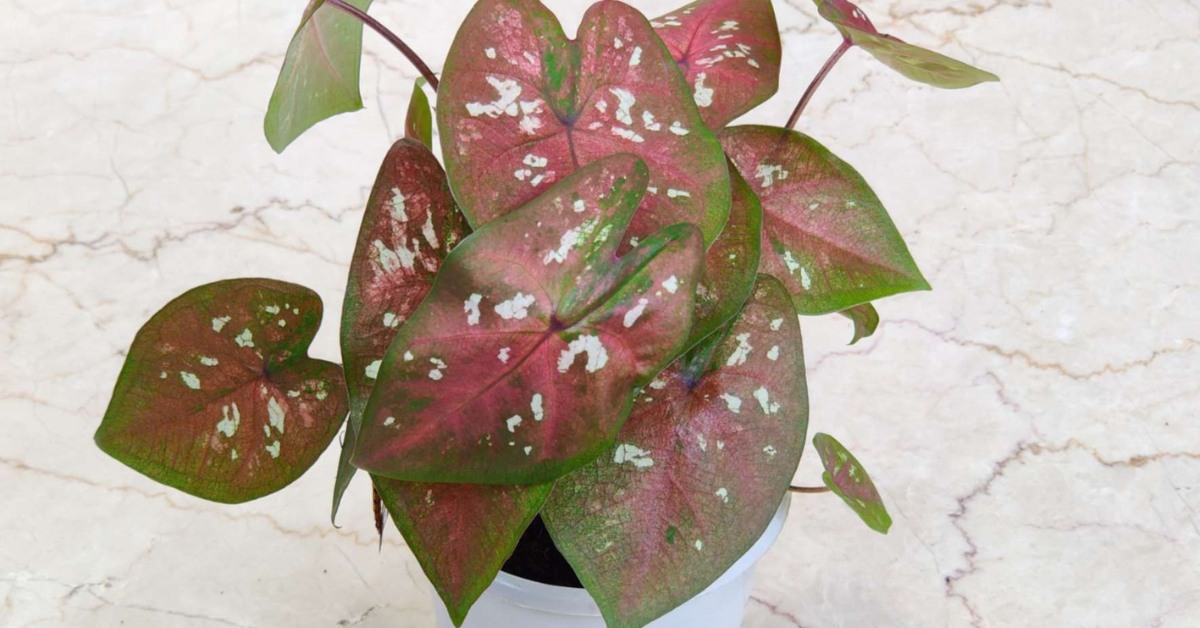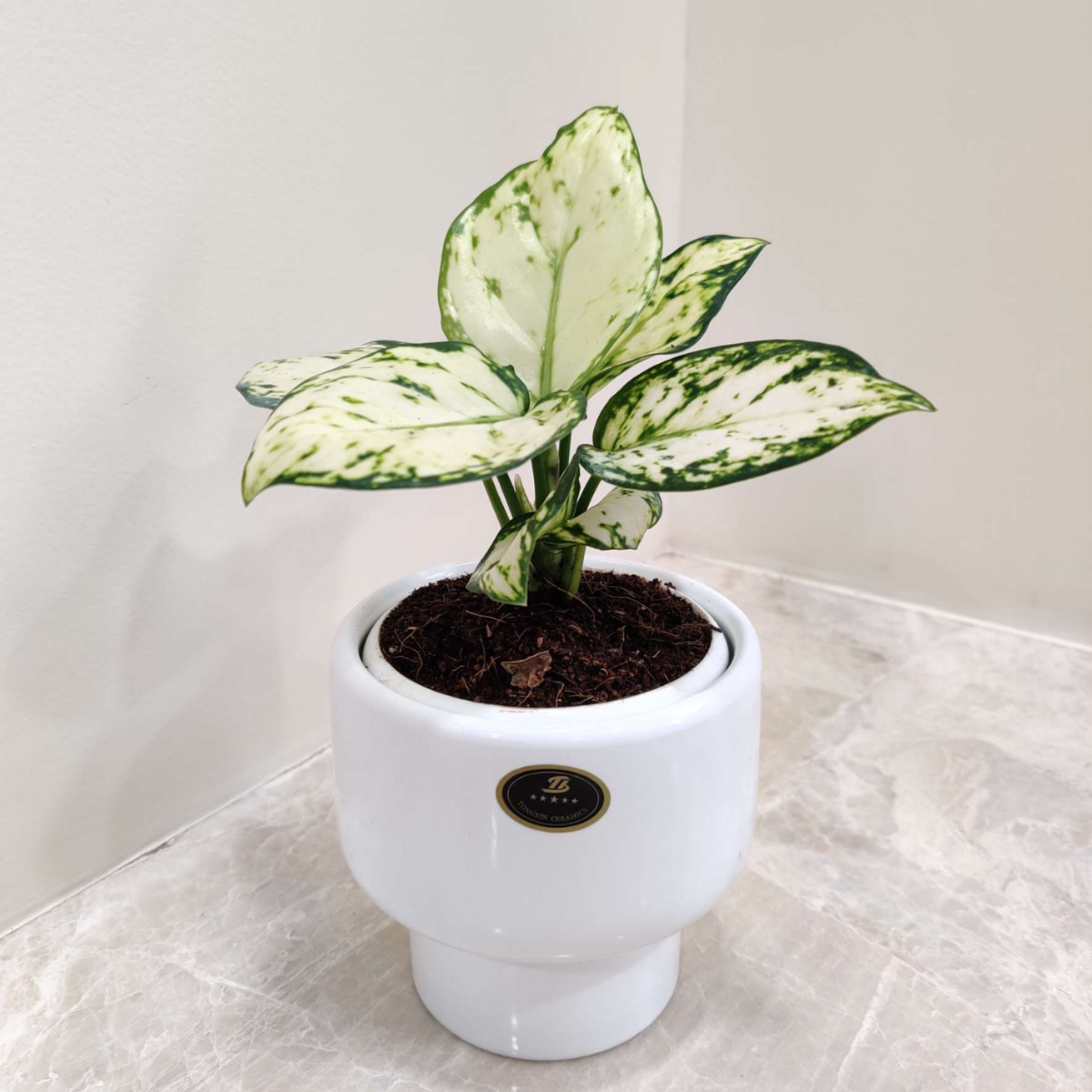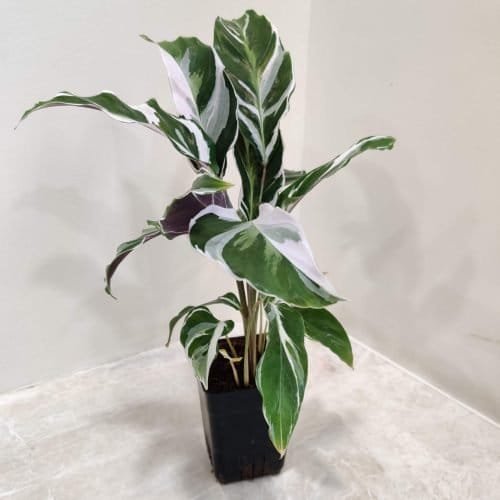
If you’re searching for a truly unique houseplant that turns heads and sparks conversation, look no further than the Calathea White Fusion (Calathea lietzei ‘Fusion White’). Often celebrated as a living piece of art, this rare tropical plant features mesmerizing variegated leaves—soft splashes of creamy white, pastel green, and bold purple undersides that shimmer in the light like a watercolor painting. A proud member of the prayer plant family (Marantaceae), it showcases rhythmic leaf movement, gently folding at night and unfurling with the morning sun.
But the Calathea White Fusion isn’t just about looks. It’s also non-toxic to pets, making it a safe and stylish choice for homes with cats, dogs, or curious little hands. While this plant has a reputation for being a bit fussy or high-maintenance, the key to success lies in mimicking its native rainforest conditions—warmth, high humidity, filtered light, and consistent moisture.
In this ultimate Calathea White Fusion care guide, we’ll cover everything you need to know to keep your plant thriving. Whether you’re a seasoned indoor gardener or a new plant parent, you’ll learn expert tips on watering routines, lighting conditions, soil preferences, pest prevention, propagation techniques, and more. With the right care, your White Fusion can become a lush, vibrant centerpiece that elevates your indoor jungle and brings calming, tropical energy into your space.
Botanical Overview: Getting to Know Calathea White Fusion
Toxicity: Non-toxic to pets and humans; toxic to fish and birds
Scientific Name: Calathea lietzei ‘Fusion White’
Family: Marantaceae (Prayer Plants)
Origin: Cultivar, not found in the wild
Common Nickname: White Fusion Calathea
Growth Habit: Herbaceous perennial, bushy form
Size: Grows 12-24 inches tall, 18 inches wide
Flowering: Rare indoors; flowers are small and scentless
Visual Appeal: What Makes It a Showstopper
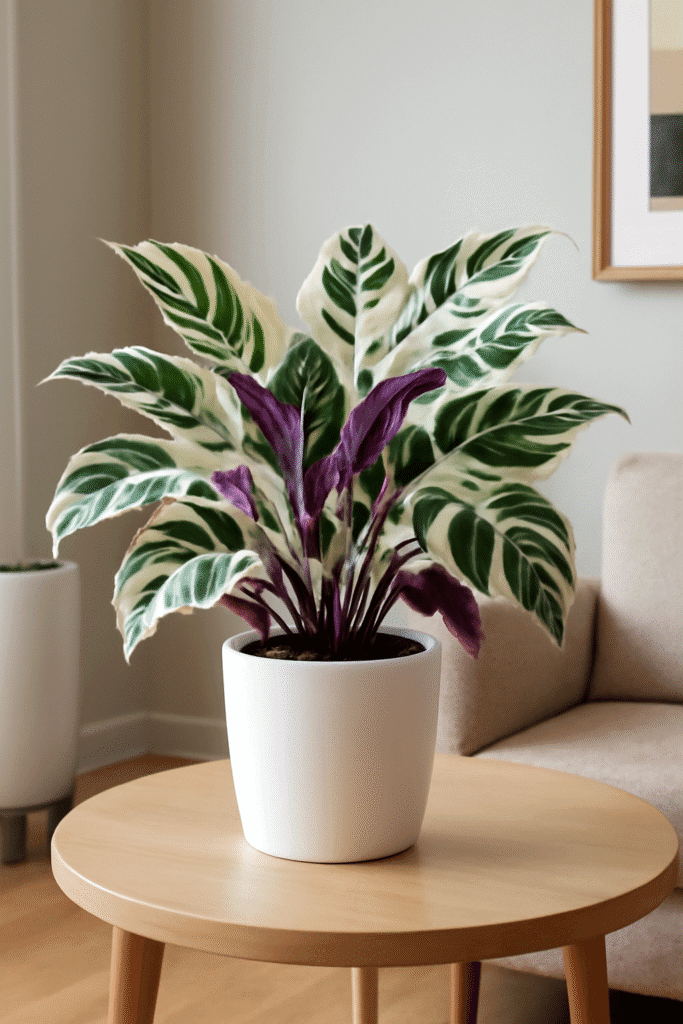
- Foliage: White and green variegation with purple-maroon undersides
- Texture: Thin, delicate, semi-translucent leaves
- Movement: Exhibits nyctinasty, folding at night like praying hands
- Statement Piece: Ideal as a standalone feature in decor
Why Choose Calathea ‘White Fusion’?
This plant is more than just a pretty face. Its bold, patterned leaves provide a touch of elegance and sophistication, making it perfect for modern interiors. As a member of the Marantaceae family, the Calathea ‘White Fusion’ also brings a natural air-purifying quality to your home, improving indoor air quality while adding a tropical vibe.
Calathea ‘White Fusion’ is like nature’s artwork in plant form! Its leaves showcase a stunning mix of white, green, and soft lilac, with the colors blending beautifully in a feathered pattern. What makes it even more special? No two leaves are alike—each one is uniquely patterned, giving every plant its own personality.
Is Calathea Good for Vastu?
If you’re looking to add a touch of nature to your space while aligning with Vastu principles, Calathea might just be the perfect plant for you! Known for its striking, patterned leaves and soothing green vibes, Calathea isn’t just beautiful—it’s meaningful too.
The Calathea and Its Spiritual Charm
Often called the “Prayer Plant,” Calathea gets its nickname from its unique habit of folding its leaves upwards at night, resembling hands joined in prayer. This fascinating movement is believed to create a calming, spiritual energy, making it an excellent addition to homes and offices.
Calathea and Vastu Energy
In Vastu Shastra, plants with lush, vibrant foliage are considered auspicious as they bring positive energy, growth, and harmony to any space. Placing a Calathea in your office or living area can boost focus, creativity, and calmness. Its soothing presence makes it ideal for stressful work environments or meditation spaces.
Where to Place Calathea for Vastu?
- Office: Place it near your desk to invite fresh energy and focus into your work.
- Home: Keep it in the living room or bedroom for a sense of serenity and balance.
- Direction: East or northeast corners are best for indoor plants as they symbolize growth and new beginnings.
Care and Positivity Go Hand in Hand
Taking care of a Calathea is as rewarding as its presence. This tropical beauty thrives in indirect light and loves a humid environment. By caring for it, you’re not only nurturing the plant but also inviting positive energy into your life.
So, if you’re looking to bring in good vibes and a touch of elegance, let Calathea be your go-to plant. It’s not just a plant—it’s a beautiful, living prayer for peace and positivity in your space!
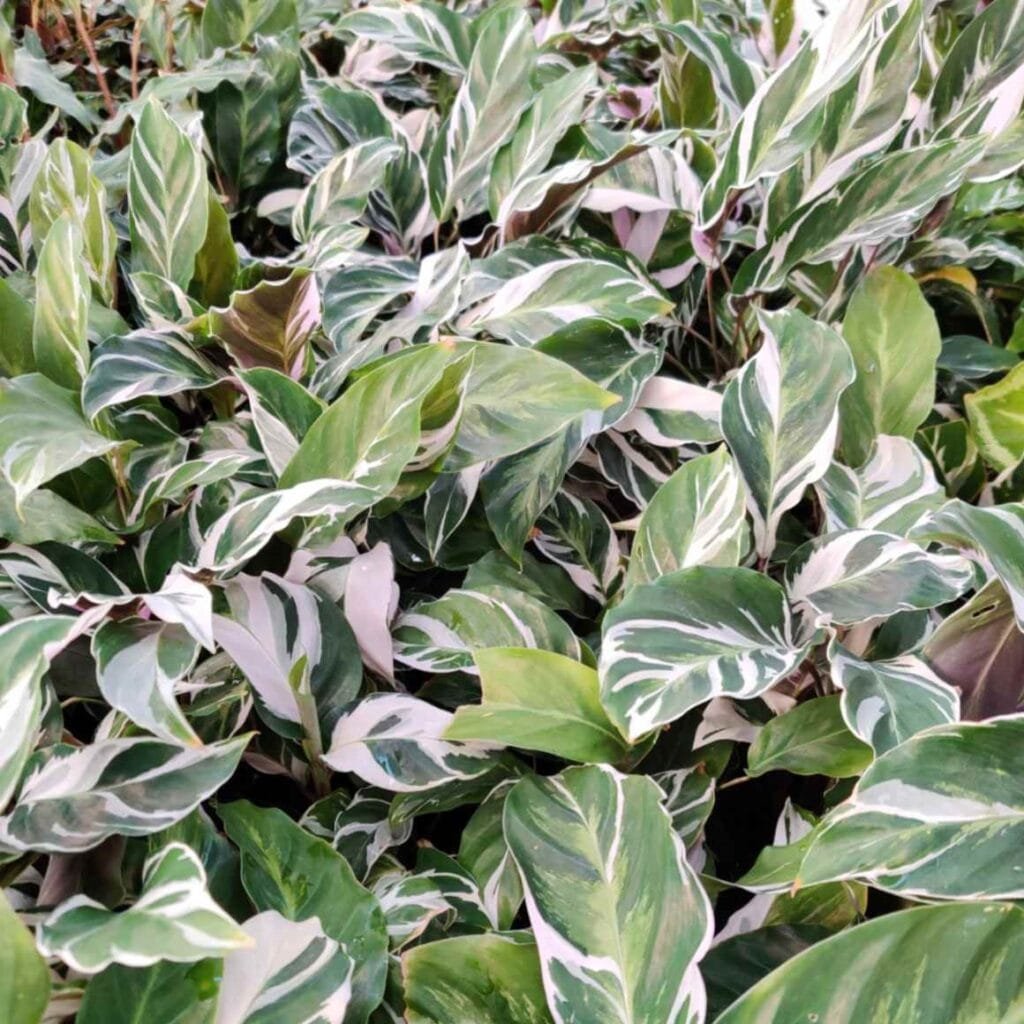
Ideal Light Conditions: Indirect and Gentle
Signs of Too Little Light: Faded markings, all-green leaves
Best Light: Bright, indirect or diffused light
Avoid: Direct sun (leads to leaf burn, fading)
North/East Windows: Ideal placement
South/West Windows: Use sheer curtains
Grow Lights: Use in winter, 18-24 inches above plant
Signs of Too Much Light: Brown, curling leaves, loss of white variegation
Watering: Consistency Over Quantity
Water When: Top inch of soil feels dry
Frequency: Every 5-10 days (more in summer, less in winter)
Method: Water until it drains out the bottom
Avoid: Soggy soil, pooling water, water on leaves
Preferred Water: Distilled, filtered, or rainwater
Tap Water Tip: Let sit overnight to dissipate fluoride
Warning Signs:
- Crispy Tips: Chemical sensitivity or low humidity
- Yellow Leaves & Mushy Stems: Root rot from overwatering
Humidity: A Non-Negotiable Need
- Ideal Humidity: 75-85%
- Minimum Tolerated: Around 60%
- Humidity Boosters:
- Humidifier (best option)
- Grouping with other plants
- Pebble trays with water
- Misting with distilled water (from below)
- Bathroom placement (with filtered light)
- Clear plastic dome for new plants
- Signs of Low Humidity: Crispy edges, leaf curl, browning
Temperature: Keep It Tropical
- Ideal Range: 60°F to 80°F (15°C to 27°C)
- Avoid:
- Below 50°F (10°C)
- Sudden temperature changes
- Drafts, air conditioners, and heaters
- Overwintering:
- Acclimate gradually to indoor conditions
- Avoid leaf drop by stabilizing temperature and humidity
Soil: The Foundation of Health
- Preferred Soil pH: ~6.5 (slightly acidic)
- Ideal Mixes:
- African Violet mix
- Custom blend: potting soil + pumice/perlite + coco coir
- Avoid:
- Orchid bark (retains too much water)
- Heavy generic soils (e.g., Miracle-Gro)
- Properties Needed:
- Well-draining yet moisture-retentive
- Aerated and fluffy
Fertilizing: Light But Regular
- Frequency: Monthly during growing season (spring-fall)
- Type: Balanced 10-10-10 or foliage-rich feed
- Dilution: Half-strength to avoid burning roots
- Alternatives:
- Slow-release granules
- Compost-rich potting mix
- Avoid: Over-fertilizing in winter
Pruning: Aesthetic and Preventive
- Purpose:
- Remove dead/damaged leaves
- Improve airflow
- Prevent rot and disease
- Tools: Sterilized scissors or knife
- Tip: Cut at base of stem; dispose of trimmings properly
Staking and Structural Support for Calathea White Fusion
Though typically compact, some Calathea White Fusion plants may develop tall, slightly drooping stems as they mature. Providing the right plant support system can enhance both health and aesthetics.
Natural & Structural Support Methods:
- Bamboo Stakes: Ideal for propping up tall or drooping leaves. Thin bamboo stakes offer subtle support without overwhelming the plant’s natural appearance.
- Moss Poles: For larger or more mature specimens, moss poles provide vertical structure and encourage upright growth.
- Plant Clips & Soft Ties: Secure stems to support structures gently using soft plant clips or flexible ties to prevent damage to delicate foliage.
Preventive Measures:
- Proper Plant Spacing: Avoid overcrowding to reduce competition for light and air circulation, helping the plant maintain its shape.
- Heavy, Stable Containers: Use weighted pots to prevent tipping, especially for taller Calatheas or those grown in mixed arrangements.
- Routine Pruning: Regular removal of wilted or overly large leaves reduces weight and promotes a balanced, bushy structure.
Propagation: Multiply the Beauty
A. Division (Best Method)
- Do it while repotting
- Gently split new clumps with roots
- Replant in smaller pots
B. Leaf Node Cuttings
- Cut below node with leaves
- Root in water or moist soil
- Transplant once roots develop
C. Growing from Seed (Rare)
- Plant ¼-inch deep in moist seed mix
- Cover for humidity; use heating mat
- Germination: up to 1 month
Common Problems and Solutions
1. Leaf Curling
Causes:
- Dry Soil & Dehydration: The most common reason for leaf curling in Calathea White Fusion is underwatering. These tropical houseplants thrive in consistently moist (but not soggy) soil.
- Low Humidity: Calathea plants prefer humidity levels above 60%. Dry indoor air causes stress.
- Excessive Light or Heat: Too much direct sunlight or heat stress can make leaves curl inward to conserve moisture.
- Temperature Fluctuations: Sudden changes, such as cold drafts or blasts from heaters/AC, can result in curling.
- Root Issues: Damaged roots or root rot impair water uptake.
Solutions:
- Adjust your watering schedule—water when the top 1–2 inches of soil are dry.
- Boost humidity with a humidifier, pebble tray, or plant grouping to maintain levels between 60–80%.
- Move plant to a bright, indirect light spot away from direct sun and temperature fluctuations.
- Use only filtered, distilled, or rainwater to avoid mineral buildup.
Want to dive deeper into why your Calathea’s leaves are curling and what to do about it? Check out our dedicated guide: Reasons Your Calathea Plant Is Curling—And How to Revive It.
2. Yellowing Leaves
Causes:
- Overwatering: The top cause of yellow leaves. Constantly soggy soil leads to root rot.
- Poor Drainage: Traps excess moisture, preventing roots from functioning properly.
- Nutrient Deficiency: Lack of fertilization causes pale or yellowish foliage.
- Pest Infestation: Spider mites or aphids may sap the plant’s strength, causing yellowing.
Solutions:
- Check if soil is too wet and adjust watering frequency.
- Ensure the pot has drainage holes and use a well-draining soil mix.
- Inspect leaves for pests and treat with neem oil or insecticidal soap.
- Fertilize monthly during the growing season with a diluted, balanced liquid fertilizer.
3. Brown Leaf Tips and Edges
Causes:
- Low Humidity: Dry air is a major factor for crispy brown leaf tips.
- Poor Water Quality: Minerals like fluoride and chlorine in tap water damage sensitive Calathea leaves.
- Fertilizer Burn: Overfeeding can lead to salt buildup and browning.
- Inconsistent Watering: Irregular watering stresses the plant.
Solutions:
- Switch to distilled, filtered, or rainwater.
- Increase humidity levels with a humidifier or frequent misting.
- Flush the soil monthly to remove excess fertilizer salts.
- Water consistently to keep soil evenly moist.
4. Fading Leaf Patterns
Causes:
- Insufficient Light: Not enough indirect light affects the variegation.
- Excessive Light: Too much light can increase chlorophyll, causing green to dominate.
- Environmental Stress: Temperature shifts, low humidity, or improper watering can lead to loss of variegation.
Solutions:
- Provide 6+ hours of bright, indirect light daily.
- Supplement with grow lights if natural light is weak.
- Minimize stress by stabilizing temperature, watering, and humidity conditions.
5. Root Rot
Causes:
- Overwatering and poor soil aeration promote fungal growth.
- No Drainage: Pots without drainage holes retain excess water.
- Contaminated Soil: Old or reused potting mix may harbor pathogens.
Solutions:
- Prune away black, mushy roots using sterile scissors.
- Repot in fresh, well-aerated and fast-draining soil.
- Improve drainage with a proper pot and perlite-rich soil mix.
- Water only when the top inch of soil is dry.
6. Pest Infestations
Common Pests:
- Spider Mites: Tiny pests that cause webbing and yellow stippling on leaves.
- Fungus Gnats: Thrive in overly moist soil and high humidity.
- Mealybugs, Scale, Aphids: Less common but can cause leaf damage and stunt growth.
Prevention and Treatment:
- Quarantine new plants for 2–3 weeks.
- Inspect regularly, especially under leaves and around stems.
- Apply neem oil spray or insecticidal soap as a natural pesticide.
- Maintain higher humidity levels to discourage spider mites.
Display & Decorative Uses
- Statement Plant: Highlight on side table or shelf
- Bathroom Decor: Benefits from humidity
- Pet-Friendly Choice: Alternative to toxic plants
- Outdoor Summer Accent: Only in shade, bring indoors before frost
Conclusion: Worth the Effort
Caring for a Calathea White Fusion can feel like a delicate dance, but the payoff is a truly breathtaking houseplant that stands out in any room. By replicating its tropical rainforest habitat with the right balance of light, moisture, and humidity, even beginner plant parents can nurture this variegated beauty to full glory. With its non-toxic nature and ever-evolving foliage, the Calathea White Fusion is more than just a houseplant—it’s a living work of art.
FAQs
1: What causes brown or crispy edges on leaves?
Usually low humidity, use of tap water with fluoride, or overexposure to sunlight.
2: How often should I water my Calathea?
Every 5-10 days, depending on humidity and temperature. Water when the top inch of soil is dry.
3: What type of soil should I use?
Well-draining and slightly acidic soil. Use African Violet mix or blend potting soil with pumice and coco coir.
4: Can I propagate Calathea White Fusion in water?
Yes, stem cuttings with leaf nodes can be rooted in water before transplanting.
5: Why are the leaf patterns fading?
Too much direct sun or too little light. Adjust to bright, indirect lighting.
6: How do I boost humidity?
Use a humidifier, pebble tray, mist regularly, or place the plant in a humid room like a bathroom.
7: Does Calathea White Fusion flower?
Rarely indoors. If it does, the flowers are small and unscented.
8: What pests should I watch for?
Fungus gnats, spider mites, aphids, mealybugs, and scale are most common. Neem oil and insecticidal soap are effective treatments.
9: When should I repot?
Every 1-2 years or when roots grow out of drainage holes.

